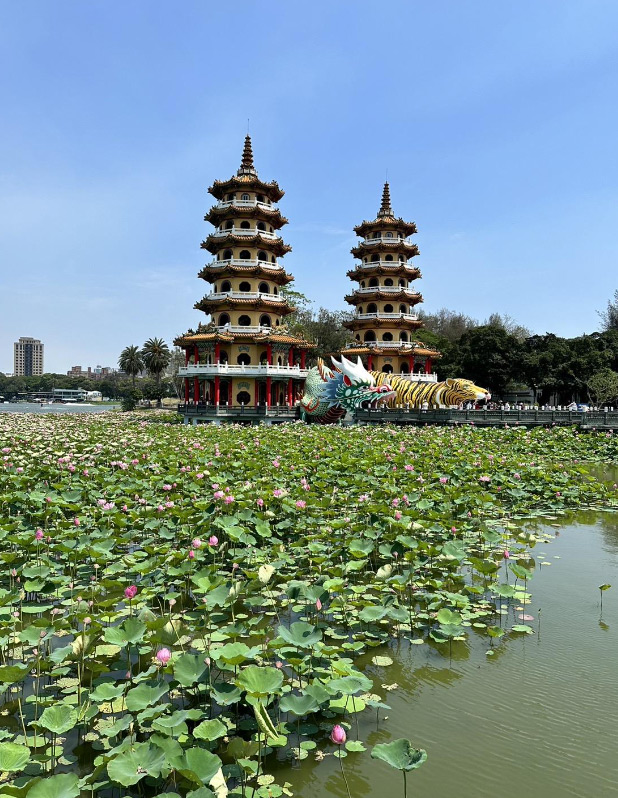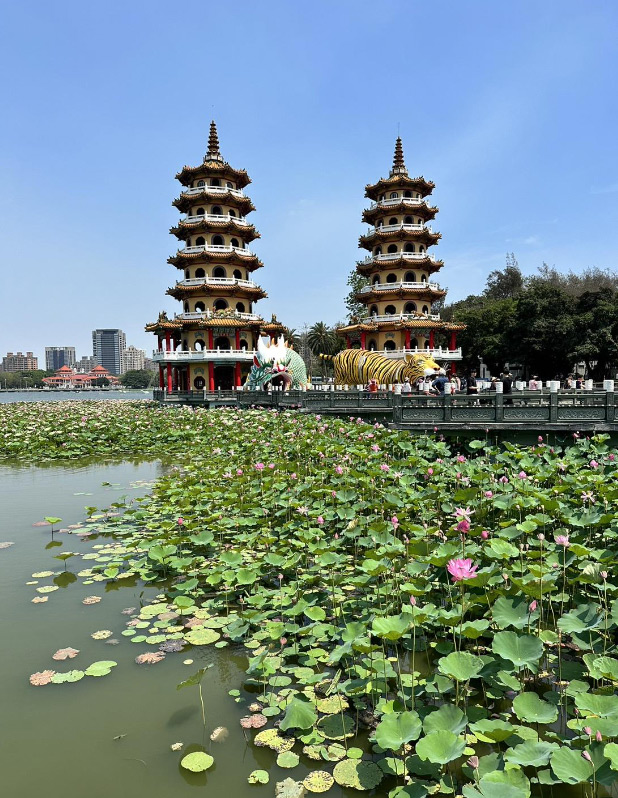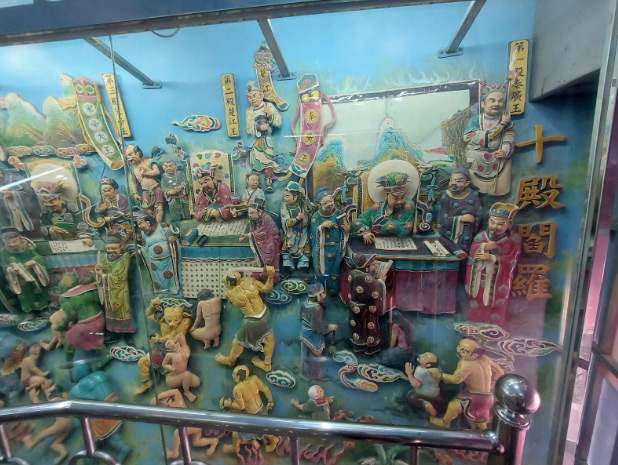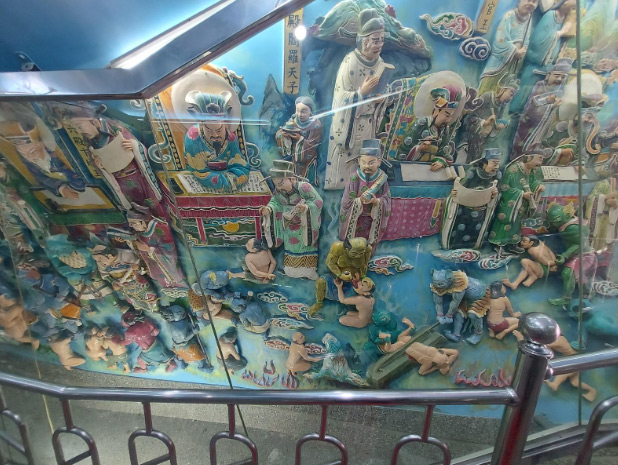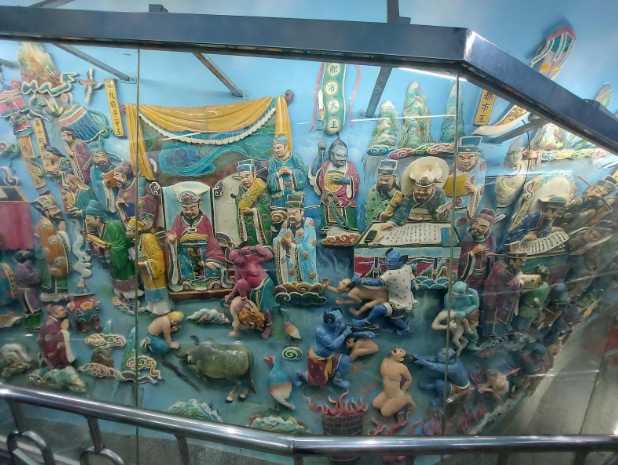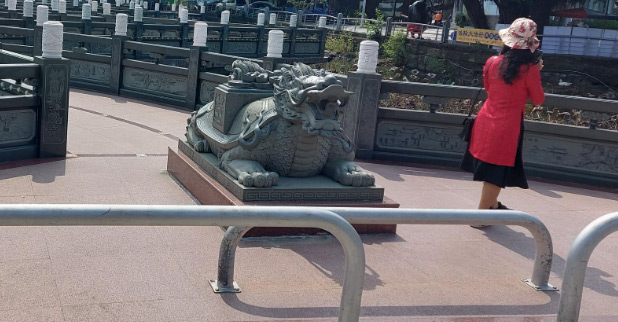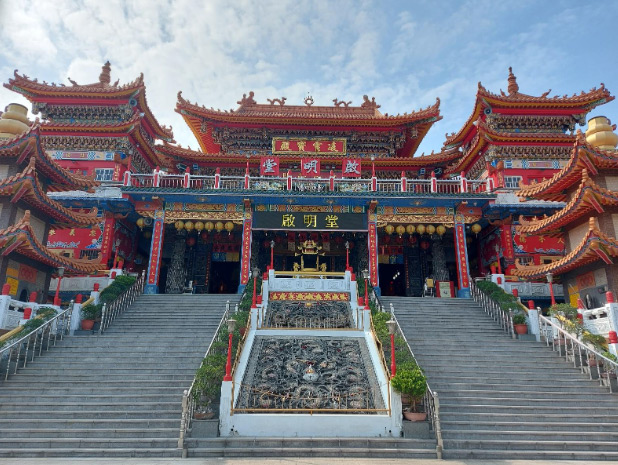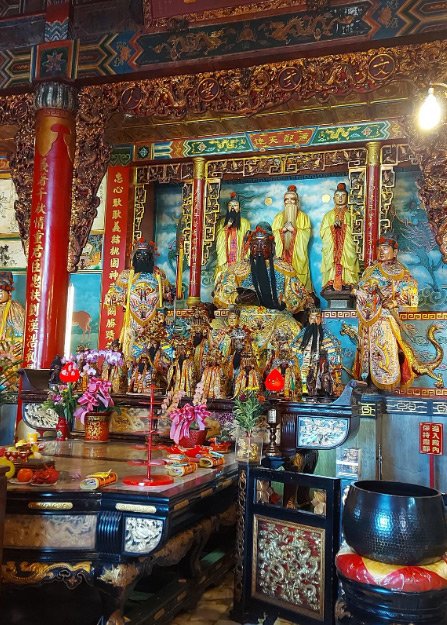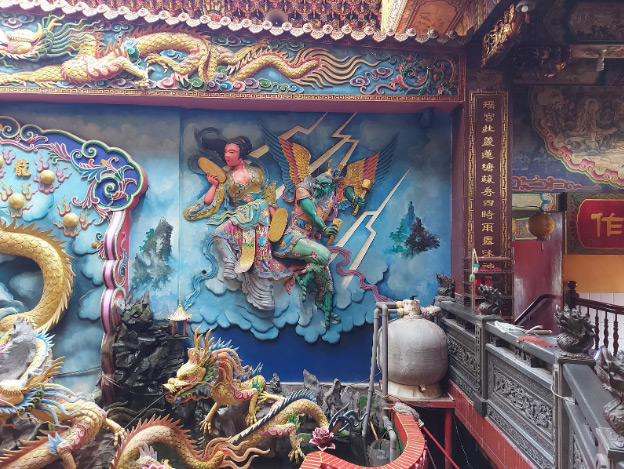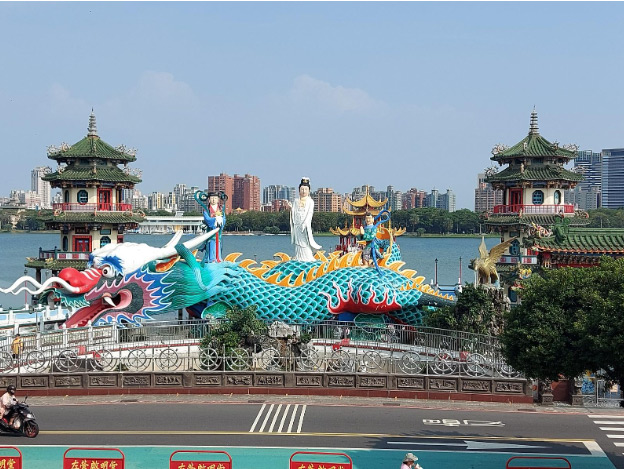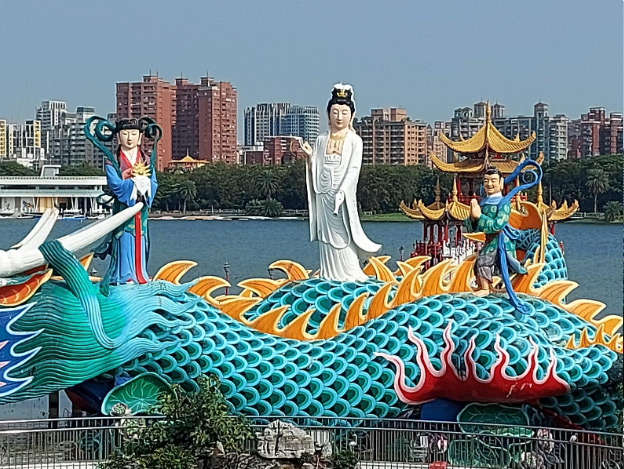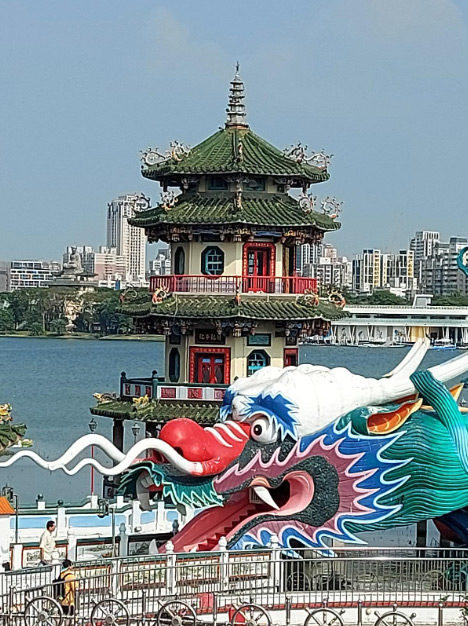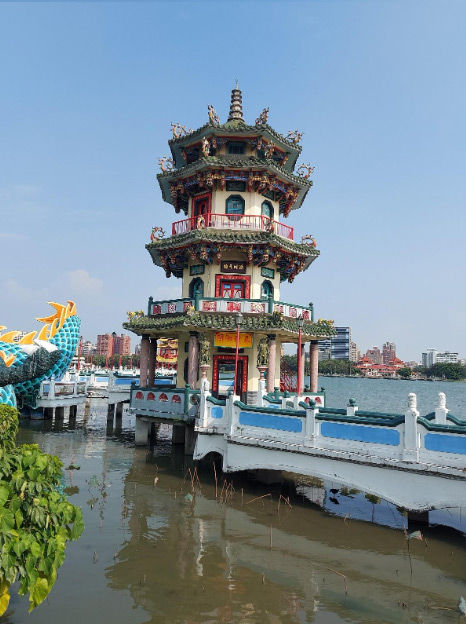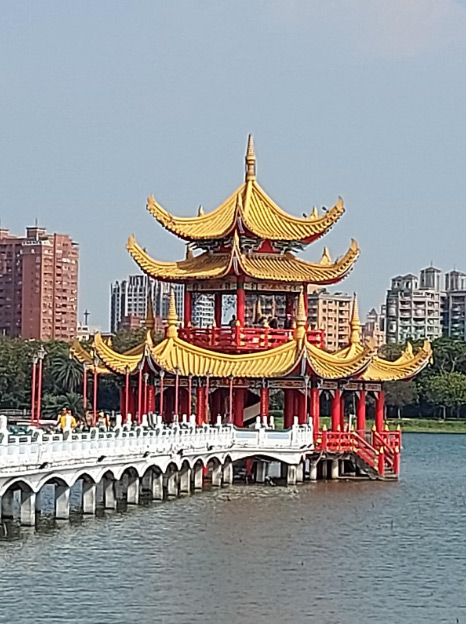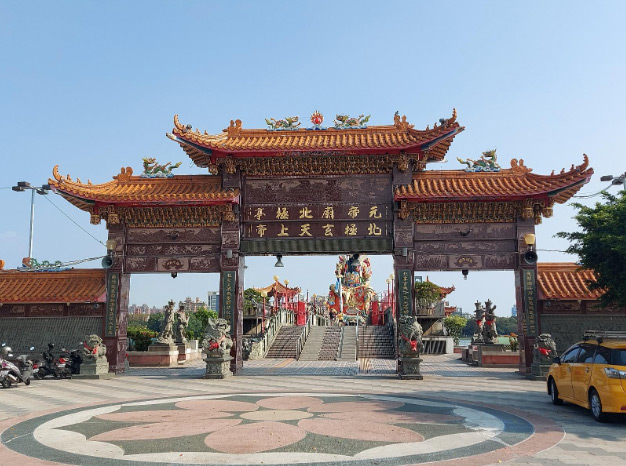文、攝影/龔書永
許多遊客到了左營,都很好奇這個地區究竟有多少座寺廟。有些人可能會想:「這裡還有其他宗教嗎?」事實上,左營舊城的寺廟密度居全台之冠。但就宗教來說,這些寺廟並非全都屬於同一個宗教,而是包含四大宗教:道教、佛教、儒教和民間信仰。許多當地人會到不同的寺廟參拜並尋求精神上的寧靜。一方面是因為大多數的人認為反正這些寺廟都是宣揚信仰虔誠的地方;另一方面則單純是因為許多信徒也不明白其中的差異。早年中國移民遷到台灣定居時,就一直採行宗教包容的作法。久而久之,各種宗教相互交織融合,變得難以分辨。這也慢慢偏離中國祖先流傳下來的原有宗教習俗,原因之一可能是台灣地處偏遠,資源匱乏。當時建築材料稀缺,不易取得。在大多數的情況下,屋瓦、磚塊和砂漿都必須從台灣海峽的另一端取得。一直到了日據時期(1895 年)才有用於燒製建築材料的窯爐。這也是為什麼不只在左營舊城,全台各地都能看到不同類型的寺廟的原因。我想多樣性確實能為生活增添色彩。
Upon arriving, many visitors wonder how many temples there are in this small town. While others might be thinking, “are there other religions?” In fact, “The old town” has the highest temple density in Taiwan. However, religion-wise, not all temples are the same. The four predominant types are Taoism, Buddhism, Confucianism, and Folk beliefs. Many locals visit different temples for prayers and spiritual serenity. On one hand, because most regard them all as institutions promoting pious doctrines; on the other, simply because many believers are not that aware of their differences either. Religious tolerance has been practiced since the era of early Chinese settlements in Taiwan. In time, all religions ended up intertwined, and hard to make out. This was something that went slowly digressing from the original religious practices taught by their ancestors back in China, and one of the reasons could be lack of resources in the frontiers. Back then, building materials were scarce and hard to get. In most cases, roof tiles, bricks, and mortar would have to be outsourced from the other side of the Taiwan strait. Kilns to fire building materials arrived much later after the Japanese occupation period (1895). This accounts for the so many different types of temples seen not just here in “the Old Town”, but also in the rest of Taiwan as well. I think it’s safe to say that variety does indeed spice up the beauty of life.
慈濟宮:道教神醫Tzu Chi Palace 【pronounce as cíjìgōng】
你是否曾經想過,如果你生病了,附近卻沒有醫生或醫院,那該怎麼辦?以前的人遇到這種狀況大多只能聽天由命,面對命運。話雖如此,古代中國人自有辦法處理。據說心地善良的保生大帝會保護虔誠的信徒,而且他的醫術高超,無人能及。相傳他能治百病,經過他的治療,就連過世的人都會起死回生,可以說是東方的耶穌基督。
Have you ever imagined what it is like to be sick without doctors or hospitals nearby? Many people in the past could only leave everything to chances and face their own destiny. Nonetheless, the ancient Chinese have their own ways to deal with this. Pao-sheng Emperor is said to be the merciful protector of faithful believers. And when it comes to medical skills, he has yet to meet any match. According to legend, no illness is uncurable, even the dead come back to life after his treatment. I think it’s fair to say that he is the eastern counterpart of Jesus Christ.
保生大帝原名吳夲,生於距今大約一千年前的宋朝。他從小就天資聰明,學習任何東西都很拿手。相傳在他17歲時,神明顯靈,賜予他祛病驅魔的法力。由於他生性寬厚且深具憐憫之心,人們一直將他視為天上眾神的化身。
Originally named Wu-tao, Pao-sheng Emperor was born in the Sung dynasty, which is roughly a millennium ago. As a child, he was smart and adept showing capability in different subjects of learning. The story goes, at the age of 17, after a divine apparition, he was granted the magical power of treating illnesses as well as exorcism. And since he was always generous in addition to compassionate, people have always seen him as the avatar of the deities from heaven.
臥虎藏龍 Crouching tiger and hidden dragon…
某天他上山採草藥時,遇到一隻氣喘噓噓、快要死掉的老虎。對動物也心善仁慈的他走向這頭野獸,想要幫助牠。他仔細一看,發現牠的喉嚨有東西,於是伸手進去,從喉嚨深處取出一根髮簪。差點噎死的老虎從痛苦中解脫後,坦承自己剛在山下吃掉一名女子。這位大夫要這頭野獸保證不再吃人,並與這頭駭人但英勇的野獸病患結交成為朋友。
One day walking down the mountain trails to gather herbal medicine, he met up with a panting and almost dead tiger. Being merciful even towards animals, he approached the beast offering his help. After an examination, he found the problem in its throat and reached out with his arm to remove a hair pin from very deep inside. At once, the tiger was relieved from the agony of being chocked to death, and confessed that he had just devoured a lady on her way downhills. The doctor made the beast promise not to ever do that again and befriended this fearful but gallant patient from the wild.
這位神醫不只在人間聲名遠播,就連神龍也跑來請他醫治。話說這條龍得了風寒,眼睛也嚴重感染,於是喬裝成凡人去看診。這位厲害的大夫一下子就識破牠的偽裝,並無私地為牠醫治。他為龍滴了一些眼藥,龍很快就恢復健康的視力。為了表達感謝,神龍跟老虎一樣就留在保生大帝身邊,幫助他鏟奸除惡,消滅陰間惡鬼。這是他從上天獲得法力的真實證明,他用法力讓凡人免於病痛之苦和邪靈危害。
The fame and reputation of this miraculous physician did not stop among human beings. Even the mystical dragon could not resist the idea of booking an appointment. Coming down with flu and serious eye infection, the dragon resorted to seeing him after showing up as an ordinary mortal in disguise. In almost no time, this magnificent doctor blew its cover while offering his altruistic medical treatment. And very quickly, some eye drops helped the dragon regain its once heathy eyesight. As a gesture of gratitude, both the tiger and the dragon have remained at the disposal of Pao-sheng Emperor, eliminating not only wrongdoers but also sinister beings from the underworld. This is a genuine proof of the divine power that he once received from heaven to keep all mortals from the pain of health issues as well as the intimidation of evil spirits.
保生大帝醫術和知識無人能及,也難怪大家都來拜他。這座寺廟與眾不同的一個特點,就是它會為前來祈求健康的人提供藥籤。信徒在燒香、祭拜、擲筊後,就會拿到類似靈籤,是尺寸稍微小一點的藥籤。不同的是,上面的內容不是在解命,而是指示信徒應該去抓哪種中藥。這個概念類似預約看診,然後再拿處方去中藥店配藥。幾百年來,現代醫學和健保出現之前,這一直是當時社會民眾的普遍作法。
Since his skills and knowledge in medicine was unsurpassed, it’s not hard to imagine why people come to worship him. One thing that sets this temple apart from all others is the Chinese medicine prescription granted to those who pray for health. After incense burning, prayer, and moon blocks casting, the believer gets a divine consultation by drawing sticks similar to a fortune stick oracle, but a little smaller in size. Only that in this case, instead of an explanation of their luck, they receive an instruction of what kinds of Chinese medicine to take. This sounds like a medical appointment, after which the prescription may be taken to a Chinese medicine store to have it filled. For centuries, this practice became a social norm until the advent of modern medicine and health care.
在距今大約五百年前的明朝,保生大帝被當時的皇帝封為「恩主昊天金關御史慈濟馨鑒妙道真君萬賽無極保生大帝」。這個稱號又長又複雜,非常難記,許多信徒連唸都唸不完整。為了化繁為簡,一直以來人們都用這個稱號的最後四個字「保生大帝」來尊稱他。
In Ming dynasty, or roughly 500 years ago, the emperor granted him a title of honor, "Imperial Inspector at Heavenly Gate, Miracle Doctor of Compassion Relief, Great Taoist Immortal, and the Long-lived Unbounded, Life-guarding Emperor” (恩主昊天金關御史慈濟馨鑒妙道真君萬賽無極保生大帝). This being complicated and too long to remember, many followers have a hard time even pronouncing his entire name. For the sake of simplicity, people throughout history call him by the name of the last four Chinese characters from the title, Pao-sheng Emperor.
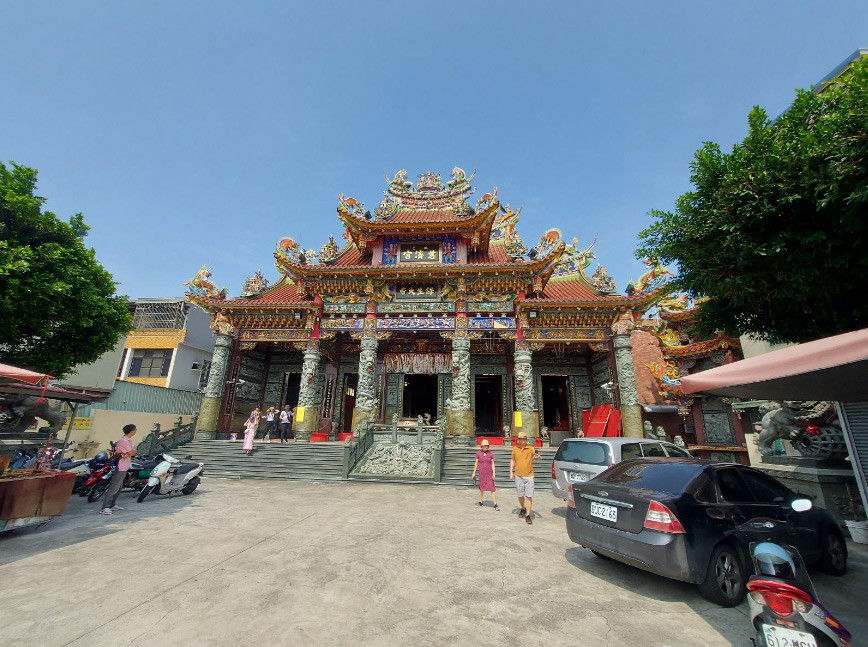
慈濟宮
Taoist Master of Medicine

他仔細一看,發現牠的喉嚨有東西,於是伸手進去,從喉嚨深處取出一根髮簪。
After checking, he found the problem in its throat and reached out with his arm to remove a hair pin from very deep inside.
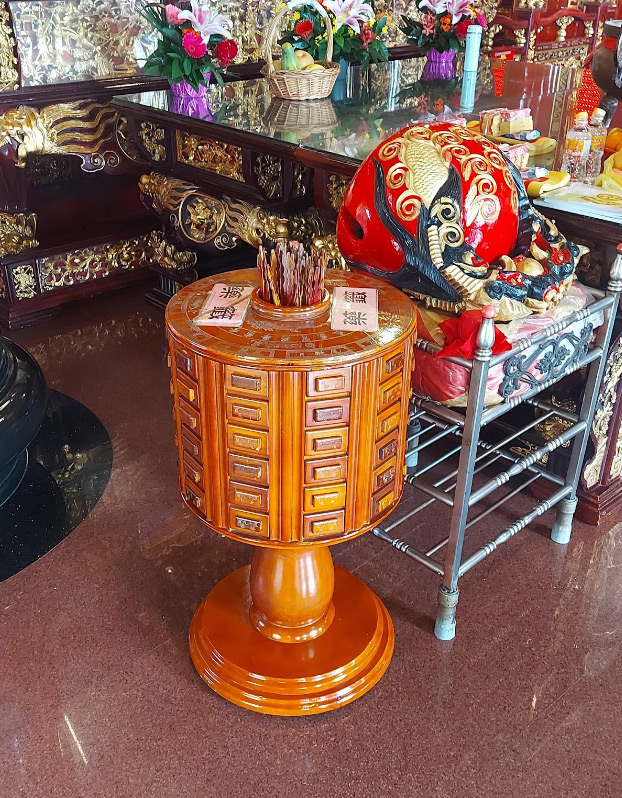
這座寺廟與眾不同的一個特點,就是它會為前來祈求健康的人提供藥籤。
One thing that sets this temple apart from all others is the Chinese medicine prescription granted to those who pray for health.
龍虎塔Majesty and Gallantry【pronounce as lóng hǔtǎ】
如果你去高雄旅遊,就絕對不能錯過這個地方。這裡是台灣十大必去景點之一。座落於蓮池潭南端的是雄偉的龍虎塔。這兩座高聳的中式傳統建築獨一無二,工藝無與倫比,許多人甚至認為這是巨大化的裝置藝術作品。對遊客來說很棒的是,從台鐵左營站步行到這裡只要 10 分鐘,你也可以租借Youbike腳踏車,從最近的高雄巨蛋捷運站悠閒地騎過來。
If you ever travel to Kaohsiung, this is a spot you definitely can’t miss. It is among the top ten must-go places in Taiwan. Located at the southern end of the Lotus Pond are the magnificent Dragon and Tiger pagodas. Nothing compares to the uniqueness and craftmanship of this monumental Chinese traditional architecture, which in the eyes of many can be even seen as an installation art on steroids.
To the delight of visitors, this place is just 10 minute-walk from Zuoying train station (TRA), or you can rent a Youbike and leisurely pedal your way from the nearest MRT station, the Kaohsiung Arena.
自有歷史記載以來,我們眼前的龜山就一直被奉為村子的守護神。遠遠望去,這座山看起來就像在潭邊飲水的烏龜,所以才會取名為龜山。早年這裡年年昌榮繁盛,後來卻發生災難,一連出現許多異象,使得人心惶惶,像是潭水變紅,魚群大量死亡,天氣詭譎多變等等。有說法指出這個地區之所以失去原有的完美狀態,是因為歷史上這裡的自然和諧被破壞多達三次。所謂的自然和諧指的就是風水,也就是英文裡的geomancy。民間流傳著不同版本的說法,但最普遍的是以下這個版本。第一次風水破壞發生在19世紀,當時有些名門望族將已故親人葬在龜山。據傳墓碑堵住這隻烏龜的鼻腔,害牠無法呼吸新鮮空氣。第二次發生在 1940年代,當時日本政府決定開通一條路,也就是現在舊城牆旁的這條路。這次情況更慘,這隻奄奄一息的烏龜差點快被勒死。第三次—也是最後一記重擊—發生在1949年台灣光復後,當時國民政府決定在山頂建造一座塔來紀念海軍將領桂永清。這座紀念塔就像棺材上的一根釘子。這隻命運多舛的神龜嚥下最後一口氣,再也無法善盡職責,保護當地居民。
Since early recorded history, the Turtle Mountain in front of us had always been seen as the patron protector of the village. In the distance, the mountain resembles a turtle drinking water from the pond, and hence the name. Early residents enjoyed year after year of prosperity and growth. Until disaster struck, a series of unexplainable and apprehensive incidents took place in the area. The pond water turned red, fish died in big numbers, the weather became unpredictable, and what not. According to some accounts, the reason why this area lost its once perfect condition was simply because the natural harmony of the place had been upset up to three times throughout history. That harmony is called feng-shui (風水) in Chinese, and geomancy in English. Different versions circulated in the public lore; but the following is the most prevalent. The first incident occurred in the 19th century, when prestigious people chose the Turtle Mountain as the burial place for their loved ones. It is said that the tomb stones simply obstructed the nose cavity of the animal, depriving it of fresh air. The second took place in the 1940s, when the Japanese government decided to open the street that currently runs adjacent to the ancient city wall. This time, the situation got even worse as the already weak animal was being strangled almost to death. The third and final blow occurred after the restoration in 1949, when the national government decided to build a tower at the peak of the hill in memory of a Navy general (桂永清). And this was the final nail on the coffin. The ill-fated mythological animal breathed its last, never to fulfill again its faithful duty of safeguarding locals.
1969年,主祀寺廟位在龜山下的保生大帝顯靈了。祂指出一場浩劫即將來臨,要大家務必不計一切準備面對將到來的磨難。祂指示人們建造龍虎塔,並規定塔的高度要高於現有的紀念塔才能鎮煞。建好之後不久,計畫果真奏效。 1977年,一場強颱橫掃台灣並重創南部地區,幸運的是,雖然風勢強勁,但財物損失和人員傷亡都被控制在最低限度之內。許多人認為這是神明保佑的原故,否則後果不堪想像。 從此,矗立在蓮池潭邊的龍虎塔,也深植在心懷感恩的當地人心裡和記憶中。
In 1969, a divine revelation came from Pao-sheng emperor, whose dedicated temple is located at the foot of the turtle mountain. He indicated that a big disaster was imminent and people must brace up for this forthcoming ordeal by any means. Therefore he commissioned the building of the Dragon and Tiger towers, stipulating that the height should be even taller than the existing memorial Tower in order to suppress the energy, or simply chi in Chinese. Shortly after the completion, the plan paid off. In 1977, a big typhoon swept across Taiwan hitting hard its southern area, but fortunately the number of losses and casualties were kept at a minimum considering the magnitude of the wind. Many people interpreted the aftermath as a sign of divine protection, which otherwise would be unthinkable. From then on, the Dragon and Tiger pagodas have stood firm and tall not only by the shore of the Lotus pond, but also in the hearts and memory of the grateful locals.
這兩座塔共有七層,塔尖還特別加長以延伸塔高。在建築風格上,黃牆、紅柱子和橙瓦讓人想起中式經典建築。據可靠消息指出,塔的頂層還藏有護身符,其法力能保護這一帶地區。在塔的底層是一對龍虎,牠們栩栩生動,雄渾有力,與塔內所描繪的主題內容相呼應。從龍口進塔,可以看到左邊的二十四孝故事和右邊的地獄血腥畫面。這些景象再再傳達一個非常清楚的訊息:對父母不孝的人會遭到可怕的報應。 在虎塔走道兩側的分別是孔門七十二賢和和三十六天將。這在中國傳統哲學中是所有人應該追求的典範:既要知書達禮,也須身強體健,就像西方人所說的身心靈和諧。走出這隻令人生畏的猛獸口中可以保你平安如意,因為「出虎口」在中文裡有吉祥的寓意。
The pagodas feature seven stories in all with extended pointed roofs to ensure their height. As for the architecture style, yellow walls on the exterior, red pillars and orange roof tiles remind us of the Chinese classics. But according to reliable sources, the top floors house a talisman in each of them to protect the vicinity with their magical power. The dragon and the tiger at the foot of the pagodas display vivid and vigorous energy anticipating the content of the themes depicted on the inside. As you make your way into the mouth of the dragon, you will appreciate the twenty-four filial piety stories on the left and the hellish gory images in the purgatory on the right. The message can’t be clearer, failing to respect and obey parents will unavoidably lead to dreaded consequences. In the tiger tunnel, the seventy-two disciples of Confucius the great master and the thirty-six generals stand on each side of the passage. Perhaps in the traditional Chinese philosophy, this is the epitome of what all persons should be like: strong both in knowledge and body, reflecting something similar to the harmony that westerners call spirit, body and soul. After walking out from the mouth of this fearsome beast, you’ve accomplished an auspicious endeavor, because “exiting the mouth of the tiger” implies good luck in Chinese.
連接塔和河岸的走道叫做「九曲橋」。有趣的是,當你走在上面,會發現這個名字的數字根本對不上,因為這座橋總共只有七曲。導遊解釋中文會用「九」來比喻「多」。 而事實上,「七」這個數字則取自七星寶劍的意涵。這個就留待下次再講。離開之前,別忘了摸幾下入口處神獸背上的「金元寶」喔。這隻名為「贔屭」的神獸是龍和龜的合體,而摸元寶的動作在中國文化中代表財富和好運。那我們下次見囉!
The connecting path from the shore is called “the bridge of the nine bends.” Interestingly, as you make your way in and out, such name simply doesn’t “add up”, there are only seven zigzags in total. After some explanation from tour guides, “nine” is only a metaphorical expression referring to “many” in Chinese. In reality, “seven” is a connotation coming from the sword of the seven stars. But I guess that’s good topic material for another episode in the future. And before you leave, don’t forget to touch a couple of times the “gold dumplings” on the back of the mythological animal standing at the entrance. This is a hybrid between a dragon and a turtle, and its name is Pi-xi. The Chinese regard this gesture as a sign of financial prosperity and good fortune. Until next time!
啟明堂 四教合一Chi Ming Palace 【pronounce as qǐ míngtáng】
如果想要一次祭拜台灣四大宗教的眾神明,來這座寺廟參觀確實是一個不錯的選擇。不但可以省去奔波於不同寺廟參拜的不便,還可以看到平凡典型的外表背後的工程壯舉。啟明堂的意思是「神明啟示」,而這正是這座建築的真正目的。啟明堂主殿後面有一座神殿,上面一座,下面又有一座,果真是名符其實的「四教合一」。主殿供奉的是台灣四大宗教都有祭祀的關聖帝君。這位豪傑是大約1800年前的忠貞將軍,他效力於一名義軍統帥。關於他的故事都是虛實參半,雖然故事含有杜撰成分,不過信徒虔誠信奉的心卻是半點不假。由於關公勤於讀書又學識豐富,因此也被稱為文聖武帝君。參觀主殿時,可以看到關聖帝君在讀手裡的經卷,這本書就是聞名古今的《春秋》,是至聖先師孔子的眾多經典著作之一。正因如此,這座寺廟吸引不同行業的信徒,例如老師、學生、會計師、軍人、警察,甚至幫派成員,可以說是各行各業的信徒都有。
For those who want to worship the many gods of the four religion types in Taiwan, visiting this temple is indeed the way to go. It will not only save you the inconvenience of going around different temples to worship but also allow you to see the marvelous feat of engineering behind the ordinary and typical façade. Chi-Ming Temple translates into “enlightenment”, which is the true purpose of this building. There is a temple behind the main temple, another one on top, and then another one below; making it worthy of the name, “four in one”. Inside the main temple is Kuan-Kong, the saint worshipped by all four religions in Taiwan. This larger-than-life figure was a loyal general working for a warlord roughly eighteen hundred years ago. The narrative of his stories falls somewhere between reality and fiction. But despite the apocryphal nature, many followers are both devout and pious. He’s also called the saint of literature and war due to his passion and prowess in relevant subjects. As you visit the main temple, you’ll see him reading from a scroll in his hand. That book is the all-time famous “Spring and Autumn”, one of the many Chinese classics by the great master Confucius. This by all means attracted believers from all walks of life, such as teachers, students, accountants, soldiers, police officers, and even members of underground organizations of gangsters. You wouldn’t be too far off to include just as many other professions among the worshippers.
這裡供奉的神還包括孔子、釋迦牟尼佛、玉皇大帝、觀世音菩薩,以及許多佛教、道教、儒教和當地民間信仰中經常提到的神明。 也許是出於熱情好客,也許是出於宗教包容,鄰近神殿的神龕內也供奉著剛才提到的其他眾多神明,再再印證四教合一特徵。這句話沒有冒犯的意思,不過對於想要圖個方便的人來說,這裡就像一個「宗教超市」,因為想拜的神這裡都有。
Other gods to worship here include Confucius, Sakyamuni buddha, Jade Emperor, Kuan-in buddha, and many deities often mentioned in Buddhism, Taoism, Confucianism, and local folk beliefs. Perhaps it was out of hospitality, or maybe due to religious tolerance, the shrines in the adjacent temples are dedicated to numerous other gods just mentioned, which confirms again its four in one feature. As a general, Taiwanese people are polytheistic because the line between local religions has always been unclear. On the other hand, worshipping more gods simply means more blessing. However, visiting many temples can be a time-consuming proposition. For those looking for an easier solution; no offense, but this is like a “religious supermarket” since there’s a god for just about everyone.
春秋閣和五里亭 The Spring and Autumn Pavilions & The Five Mile Gazebo 【pronounce as chūn qiūgé & wǔlǐtíng】
在1953年時,蓮池潭只有春秋閣這一座水上建築,還沒有我們現在看到的其他寶塔和雕像。事實上,在大多數當地人的認知中,春秋閣就是蓮池潭的代名詞。青瓦、黃牆、八角截面的塔樓都是中國古典建築風格的重要元素。
Back in 1953, the only man-made structure on the surface of the pond were the Spring and Autumn Pavilions. Other pagodas and statues we can see today were not even built yet. In fact, to many locals in their fifties and beyond, the name of these two pavilions eventually became the equivalent of the Lotus Pond. They’re so venerable that up until today, many people still use them interchangeably. Green roof tiles, yellow walls, octagonal cross-section towers are all quintessential elements of the Chinese classical style.
元帝廟北極亭Beiji Pavilion, Yuandi Temple【pronounce as yuándìmiàoběi jítíng】
左營寺廟密度居全台之冠的原因不言而喻,且處處能見源於中國的神明與神祇。其中,玄天上帝與東方信仰的關係尤為特別。西方普遍稱北斗七星為Big Dipper(英國稱之為Plough),而古時候的中國稱之為玄武,是一種駭人聽聞的危險怪獸。唐朝時期,玄武的形象更被塑造成龜蛇合體。有趣的是,根據不同人的解讀,這七顆星的涵義也有所變化。後續的故事概要便是玄天上帝憑一己之力制伏了會吃人的怪獸,解救眾生。前往蓮池潭的路上,遠遠便能看到一座高達二十四公尺的古代戰士,左手持劍,右腳踩著一支烏龜及一條蛇,是東南亞最高的水上雕像。民間流傳玄天上帝從中國北方落腳蓮池潭的千百種說法,各有其特色。我認為最令人信服的,莫過於左營的玄天上帝故事,因龜山及蛇山不僅見證了鳳山舊城的興衰,更在早期貿易時期扮演了地利的關鍵角色。玄天上帝手握的七星劍名稱其來有自。據傳,七星劍為龍虎塔對面寺廟的主神保生大帝所有。而玄天上帝向其借劍的條件,是將自己的三十六名兵將暫時交由保生大帝差遣。在借劍期間,祂們也替對方保管物品,直至鎮壓世間所有魑魅魍魎。此舉不僅展現了好鄰居的特質,更凸顯了朋友存在的意義。
For good reasons this area has the highest temple density in Taiwan. In fact, many different gods and deities from China can be found here. Among them, Xuan-Tien Emperor stands out for his connection to astrolatry. What westerners call the Big Dipper (or the Plough in the UK), the ancient Chinese call it Xuan-Wu, the name of a dreadful menacing monster. During the Tang dynasty, it was depicted as a hybrid of a turtle and a snake. It’s interesting that depending on who you ask, these seven stars of the constellation can be interpreted as different things. Long story short, Xuan-Tien Emperor saved the day for everyone by subduing the man-eating monster under his power. As you make your way to the large statue on the Lotus Pond, you’ll see a majestic 24 meter tall ancient warrior with a sword in his left hand and stepping on a turtle and a snake under his right foot. In fact, it’s the tallest statue built on the water in southeast Asia. Different narratives circulate as for how Xuan-Tien Emperor made his way from northern China to the Lotus Pond. But I personally find it obvious because the most important elements of his story can be found here. The Turtle Mountain and the Snake Mountain witnessed the rise and fall of the Feng-Shan Old Town and they also played a vital role in the selection of the location to start a trade settlement in the early times. And it’s not by coincidence that the sword has a peculiar name, the sword of the Seven Stars. According to legend, it’s a property of Pao-Sheng Emperor, the main God in the temple across the street from the Dragon and Tiger Pagodas. Xuan-Tien borrowed the sword under the condition of temporarily sending his 36 warriors at the disposal of Pao-Sheng. In the meantime, each of them will have the other’s possession until all demons and evils in the world are kept at bay. This is another example of what a good neighbor should be like; after all that’s what friends are for.
漫步在左營舊城,伴隨著引人入勝又有趣的歷史故事,著實令人著迷。聽完故事後,就連當地居民也會感到驚訝,慢慢在腦海中拼湊起一個個記憶碎片。僅憑一次造訪,很難全盤理解及感受左營豐富的歷史,建議多來幾趟舊城,才能體驗到早期居民的心境,並對左營有更深一層的認識。
The most interesting thing about walking around in old towns like this is that it’s full of breathtaking and fun stories from the ancient past. Even locals find it astonishing when many dots in their minds are slowly connected together into one solid piece. It’s fair to say that once is never enough to comprehend and enjoy the rich history behind. You need to visit the Old Town as many times to feel and even experience the mindset of those early settlers and then make sense of it all.

